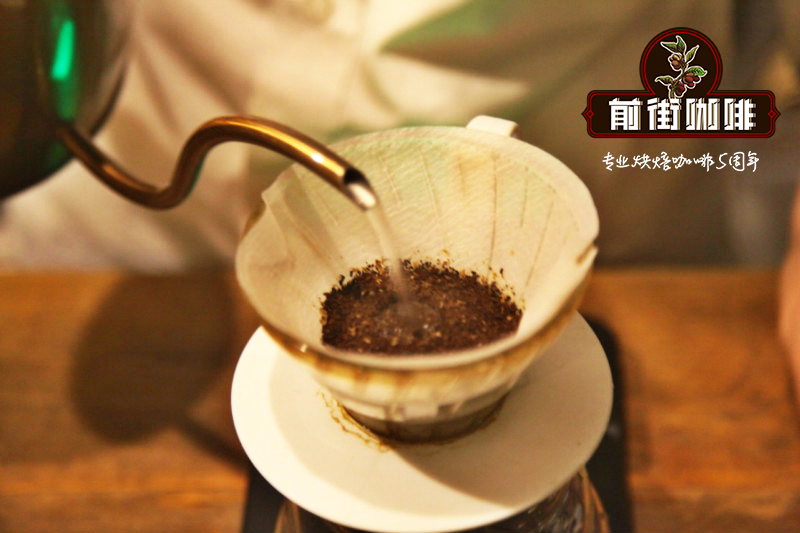Craft coffee making process explains the craft of handmade coffee making and knowledge sharing

Professional coffee knowledge exchange more coffee bean information please follow the coffee workshop (Wechat official account cafe_style)
Although handmade coffee looks simple, it can definitely make a professional and authentic cup of coffee if it is well controlled.
First, the warm cup of handmade coffee
We all know that the tannins in the coffee not as expected will work, making the coffee very sour, so we should pour hot water into the coffee cup before we start brewing the handmade coffee.
Second, ground beans made by handmade coffee
The thickness of handmade coffee should also be adjusted according to the characteristics of coffee beans, the powder thickness of deep-roasted coffee beans should be slightly thicker than that of medium-deep roasted beans; specifically, the deep-roasted coffee beans of carbon-roasted coffee should be 4; and the medium-to-deep roasted beans such as Blue Mountain should be 3.5; if the bean powder is too coarse, the coffee run out is not strong enough, if it is too fine, the coffee will be very bitter. There is also the problem of the quantity of coffee beans. The amount of beans in a cup of coffee is 12-14g, while the quantity of two cups should be calculated by formula. The quantity of three or more cups is three times as simple as 30g, four cups, 40g, and so on.
Combination utensils for handmade coffee making
Handmade coffee is mainly composed of three parts: filter paper, filter cup and filter pot; if you pay attention to it, there should be an incubator under the filter pot to avoid the coffee from getting cold when brewing; the size and specifications of filter paper, filter cup and filter pot should match each other; for example, filter paper for two people should be matched with filter cup for two people.
Transfer bean powder made by hand-made coffee
Pour the ground soybean powder into the combined filter paper, then gently pat the filter cup to flatten the surface of the soybean powder, so that the powder can receive water evenly in the following steps.
Fifth, the warm pot of handmade coffee
Pour a small amount of hot water into the bottom pot, shake it a few times, then pour it out, and then put the solid bean powder on the bottom pot.
VI. Steaming of handmade coffee
The purpose of steaming is to stuffy out the aroma of coffee and prepare for the second brewing; the water temperature of steaming should be 93 degrees. Pour water from the center of bean powder and circle it for 2-3 times, so that all soybean powder can absorb water evenly, and it is best for water drops to drop 3-5 drops; soybean powder will expand after absorbing water, from the previous flatness to a protruding arc, at this time, you can smell the faint fragrant smell of coffee powder. This step is one of the decisive factors in determining the success of a cup of handmade coffee.
Seventh, the brewing of handmade coffee
After steaming, put the kettle on a moist mouth cloth to cool it. After 25-30 seconds, the water temperature drops to 89-91 degrees, and it can be brewed. Generally speaking, the water temperature of moderately roasted coffee beans is 91 degrees, which can better extract the aroma of coffee beans. While the brewing temperature of deep-roasted coffee beans is 89 degrees, this water temperature is enough to extract the aroma and bitterness of coffee beans. If the water temperature is too low, it looks a little light, and if the water temperature is too high, it will be overcooked and extremely bitter.
The brewing water can be a little thicker than the steaming water, but it must also be stable; the amount of coffee can be controlled by the number of laps and the speed of the water flow, whether it is brewing one or three cups of coffee, you only need to inject water in a circle from the center, and then go back to the center from the outer circle to collect water from the center, and the brewing will be over; in the brewing process, be careful not to wash the water into the filter paper, otherwise the handmade coffee will be very astringent. Generally speaking, the amount of coffee brewed should be 0.5 more than the mark of the next pot, otherwise the amount of coffee will not be enough.
8. Cups made by hand-made coffee
Before filling the cup, you should gently shake the coffee in the pot to make it thick and weak, so that each cup of handmade coffee tastes evenly; then pour out the water from the warm cup, pour the coffee into the cup and set the plate to serve.
Matters needing attention in the production of handmade coffee
The whole handmade coffee brewing process from warming cup to filling cup to drinking (within 4 cups), the time should not be more than 2 minutes, otherwise the taste of handmade coffee will become sour, astringent and lose the aroma that handmade coffee should have.
Thank you for reading.
Important Notice :
前街咖啡 FrontStreet Coffee has moved to new addredd:
FrontStreet Coffee Address: 315,Donghua East Road,GuangZhou
Tel:020 38364473
- Prev

Which brand of freshly ground coffee is Starbucks coffee freshly ground? How much is a cup?
Professional coffee knowledge exchange more coffee bean information Please pay attention to the coffee workshop (Wechat official account cafe_style) Starbucks Coffee headquarters has always adhered to the concept of natural, healthy, nutritious and delicious drinks. Starbucks freshly ground coffee is made with fresh and rich ingredients, bringing more consumers healthy natural drinks. So, Starbucks Coffee Price list 201
- Next

Video teaching of siphon coffee making process the cooking method of siphon coffee pot-immersion filtration method siphon type
Professional coffee knowledge exchange more coffee bean information please follow the coffee workshop (Wechat official account cafe_style) siphon pot, also known as vacuum pot, its main principle is to heat the water in the lower bottle to make the boiling water vapor pressure, press the boiling water into the upper layer to brew the coffee through a glass tube, and then cool the lower layer in a similar vacuum to absorb the upper layer brewed coffee and filter it in the middle.
Related
- What is the meaning of lactic acid fermentation with coffee bean treatment?
- How to judge the state of foam by sound?
- How does the latte pull out the unicorn pattern? Come to get for a little trick to improve the flower pull!
- Will flower pulling affect the taste of the latte?
- Do you know the history of coffee?
- The difference between honey treatment and sun washing what is raisin honey treatment?
- What kind of milk can a novice use to make coffee foam to keep the foam longer? The correct method and skills of milking tutorial sharing
- Why do washed coffee beans taste sour? Flavor characteristics of washed Coffee
- Introduction to the skill of how to practice the size and height of water injection around the circle of hand-brewed coffee
- How do beginners practice coffee flower drawing from scratch?

